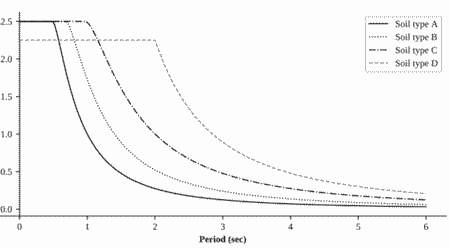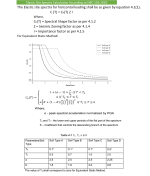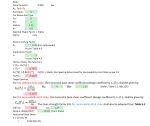NBC Seismic Load Calculation

Description
The National Building Code (NBC) of India is a comprehensive document that provides guidelines for the design and construction of buildings and structures in India. The NBC includes provisions for seismic load calculations to ensure that structures are designed to withstand earthquake forces. The NBC's seismic design provisions are primarily based on the Indian Standard code IS 1893: 2016, which provides criteria for earthquake-resistant design of structures.
Here are the main steps involved in seismic load calculations as per NBC and IS 1893: 2016:
-
Seismic zone classification: Determine the seismic zone of the location where the structure is being built. India is divided into four seismic zones (II, III, IV, and V), with Zone II having the lowest seismic hazard and Zone V having the highest.
-
Site-specific soil conditions: Perform a geotechnical investigation to determine the soil type at the construction site. Soil types are classified as hard rock (Type I), rock (Type II), dense soil (Type III), medium soil (Type IV), and soft soil (Type V).
-
Determine the design response spectrum: Based on the seismic zone and soil type, obtain the design response spectrum from the NBC or IS 1893: 2016. The design response spectrum defines the relationship between the spectral acceleration and the natural period of vibration for the structure.
-
Seismic coefficient calculation: Calculate the seismic coefficient (Ah) using the equation:
Ah = (Z * I * Sa/g) / (2 * R)
Where:
- Z is the seismic zone factor
- I is the importance factor (based on the structure's importance)
- Sa is the spectral acceleration coefficient (obtained from the design response spectrum)
- g is the acceleration due to gravity (approximately 9.81 m/s²)
- R is the response reduction factor (based on the lateral force-resisting system used)
- Base shear calculation: Calculate the base shear (Vb) by multiplying the seismic coefficient (Ah) by the total seismic weight (W) of the structure:
Vb = Ah * W
-
Distribution of seismic forces: Distribute the base shear vertically along the height of the structure according to the NBC or IS 1893: 2016 guidelines. Typically, the distribution is based on the mass and height of each floor, with higher floors experiencing less seismic force than lower floors.
-
Lateral force calculation: Determine the lateral forces acting on each floor by multiplying the floor's seismic weight with the corresponding seismic coefficient.
-
Design of structural elements: Use the calculated lateral forces to design the structural elements, such as beams, columns, and shear walls, to resist the seismic forces. Ensure that the structure meets the NBC or IS 1893: 2016 requirements for ductility, redundancy, and other seismic design criteria.
It is important to note that the seismic load calculations described above are based on a linear static analysis. For more complex structures or situations with significant nonlinearity, a dynamic analysis, such as response spectrum analysis or time-history analysis, may be necessary to accurately determine the seismic forces acting on the structure.
The NBC and IS 1893: 2016 provide comprehensive guidelines for seismic load calculations in India. Engineers should follow these guidelines to ensure that structures are designed to withstand earthquake forces and minimize the risk of collapse or significant damage during an earthquake.
Calculation Preview
Full download access to any calculation is available to users with a paid or awarded subscription (XLC Pro).
Subscriptions are free to contributors to the site, alternatively they can be purchased.
Click here for information on subscriptions.





